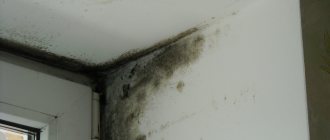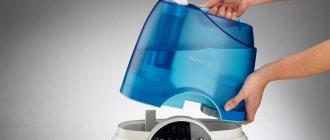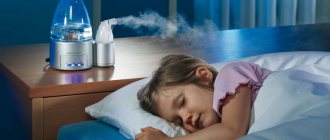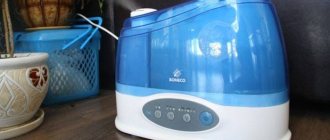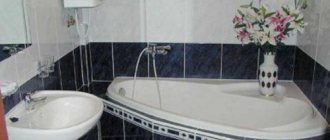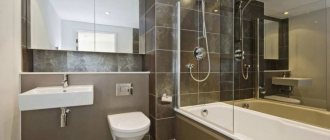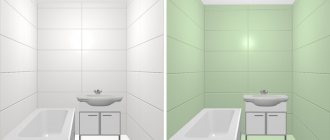What air humidity should be in the apartment?
In an apartment without children
To ensure that all household members live comfortably and breathe easily, maintain an optimal level of humidity and temperature in the apartment. Dry air irritates the mucous membranes of the eyes and nasopharynx, provokes allergic reactions and diseases such as bronchitis or asthma.
Provide regular access to fresh air, this way you will achieve natural air humidification in your living space. A humidity level of 30-60% is considered normal. For an adult, it is recommended to ventilate while resting at night using a slightly open window; this is true even in winter.
Advice: follow the recommendations of physiologists; according to them, a comfortable level of humidity in the house does not depend on the time of year and, according to sanitary and hygienic standards, is 40-60%.
Optimal air humidity
In the children's room
The child's body is more susceptible to the influence of negative environmental factors. Observe certain conditions to create climatic comfort in the children's room. Maintaining proper air humidity is one of the most important factors preventing the development of various diseases.
The humidity norm is 50-60%. A comfortable microclimate prevents drying out of the mucous membranes of the nasopharynx, which are a natural barrier that protects the body from infection.
If the child is sick, create a high level of humidity in the nursery - 70%. Such measures will allow you to quickly cope with the infection and resist the increased proliferation of bacteria on the mucous membranes.
The optimal humidity in a nursery for newborns should be at least 60%. For babies in their first year of life, it is very important to maintain high humidity in the room, since the heat exchange regime of newborns is imperfect.
When exhaling, the baby’s body loses moisture, so the inhaled air must compensate for it, otherwise all the baby’s strength is spent on moisturizing it, and there is a high risk of dehydration. Dry and hot air provokes sweating, another reason for the loss of precious moisture. For a child, this is fraught with disruption of the functioning of organs and body systems and frequent diseases.
Expert opinion
Nikonorov Vladimir Alekseevich
Our expert. Specialist in the field of air conditioning and ventilation with 10 years of experience.
Ask a Question
Strictly observe optimal climatic conditions, maintain the temperature and relative humidity in children's rooms at the proper level! If necessary, adjust it in the required direction. This is the responsibility of every parent!
Impact of high and low humidity on the body
Standard indicators according to GOST
| Age | Summer period | Winter period |
| For adults | 30-60 % | 30-45 % |
| For children | 50-60 % | 50-60% |
| For newborns | 60-70 % | 60% |
Problems arising from lack or excess moisture
Dry indoor air provokes increased moisture loss through the skin and respiratory tract. This can lead to such unpleasant consequences as:
- decreased elasticity of hair, nails and skin, accompanied by the appearance of microcracks, wrinkles, peeling, dermatitis;
- drying of the mucous membrane of the eyes, the symptoms of which are itching, redness, and a feeling of “sand”;
- thickening of the blood, leading to a slowdown in blood circulation, weakness, headaches, decreased performance, and increased stress on the heart;
- an increase in the viscosity of gastric and intestinal juices, causing a slowdown in digestion;
- drying out of the mucous membranes of the respiratory tract, which results in a weakening of local immunity and an increase in the frequency of acute respiratory viral infections;
- an increase in the amount of respiratory allergens in the atmosphere, which should normally be bound by liquid droplets.
Excess moisture in the air creates acceptable conditions for the growth of mold, fungi, and bacteria. As a result, you may encounter the following problems:
- 262 218
More details - 234 216
More details
- 540
More details
- 164
More details
- respiratory diseases - chronic runny nose, bronchitis, asthma, allergies; feeling of stuffiness or dampness in the room;
- unpleasant odor due to the proliferation of pathogenic microorganisms;
- increasing the drying time of washed laundry.
Excessive or insufficient amount of moisture in the house has a bad effect on the condition of home furnishings. Plants dry out or begin to rot, wooden furniture and parquet floors become deformed or “shrink,” paintings fade, paper products lose their structure.
How to measure air humidity in an apartment
Control the microclimate using a hygrometer, a device that measures the humidity in the apartment. There are several types of hygrometers:
- psychrometric - determines the value of relative humidity; to decipher the readings, you need to compare the data with a psychrometric table;
- electronic - very easy to use, data is displayed on the screen as a percentage;
- ceramic - mechanical method of action, based on identifying the level of electrical resistance under the influence of moisture;
- hair - based on the ability of human hair to change length depending on the influence of moisture;
- weight - determines the absolute humidity of the air;
- condensation - the most reliable indicators, the principle of operation is based on the analysis of the total amount of condensate.
If you don’t have a hygrometer, you can find out the information of interest using a room temperature measuring device and an Assmann table. A kind of home psychrometer. Record the room temperature readings from the thermometer, then wrap the tip with a well-wetted cloth and leave for 5 minutes. Having determined the result, calculate the difference between the readings of the dry and wet thermometer; to decipher the value, use the psychrometric table.
If it happens that you don’t have a room thermometer at hand, and you don’t know how to measure humidity, folk methods will come to the rescue. Naturally, these methods will not provide accurate data on the moisture level in the apartment, but they can indicate an increased or decreased microclimate.
- Fill a glass with cold running water and place in the refrigerator for 3 hours. After the specified time has passed, remove the glass and place it in a room away from heat sources. To start the experiment, you should wait 5 minutes, then evaluate the result.
| reduced | average | increased |
| the walls are dry | the walls remained foggy | drops flow down the walls in streams |
- You need a piece of plywood and a spruce branch, the length of which is 30 cm. Fasten the cut to a plywood sheet, mark the place where the loose end ends. Under the influence of moisture, it will change its position; it is necessary to record changes on the sheet daily, checking the readings of the hydrometeorological center. This way you will learn how to determine readings on a homemade moisture meter.
- For the third method you will need a fir cone. Take the pine cone and place it away from heat sources. Under the influence of high air humidity, the scales of the cone will press against each other. And if there is not enough moisture, they will open.
Table: humidity standards in different rooms
Expert opinion
Nikonorov Vladimir Alekseevich
Our expert. Specialist in the field of air conditioning and ventilation with 10 years of experience.
Ask a Question
If you want to find out where the source of high moisture is in your home, arm yourself with a piece of glass. Go to the wall and apply it, and after a short time, examine it. If you find traces of condensation, this means the source is factors outside the room; if everything is dry, then the cause is inside the apartment.
Ways to change the humidity level in a room
How to determine the moisture level in a room? There are four methods to use. The best way is to use a measuring device - a hygrometer. He will cope with the task perfectly. But what to do if this measuring device is not available? The means at hand will help you find out the value of moisture. Of course, you won’t get an exact value, but you can find out what the air needs: humidification or drying?
Let's look at each method in more detail:
- Using a measuring device. The device will not only show the percentage of moisture, but also the temperature inside the room. How many types of hygrometer are there? Today there are several types of hygrometer: psychrometric, mechanical, electronic and others. It is recommended to use an electronic device because it gives more accurate readings and, if necessary, you can easily move it anywhere indoors.
- Application of the Assmann psychrometric table. Record the temperature values on the thermometer. The head of the mercury thermometer must be wrapped in a napkin, which must be wet beforehand. At the end of ten minutes, it is necessary to record another temperature result again. Next, you need to subtract two temperature indicators. You need to subtract the second from the first. Then use the Assmann psychometric table. In the left column, which is located vertically, you need to find the first temperature indicator, and in the upper horizontal part, find the difference between your values. The intersection of these two values will show your approximate humidity level.
- Using a glass filled with water. Place it inside the refrigerator. The water temperature should drop to five degrees. Pay attention to the outer wall of the glass, namely to the reaction of water, which occurs at 20-25 degrees Celsius for seven minutes. If during this time the outer wall was able to fog up and dry out almost immediately, therefore, the air in the apartment is very dry. If the wall remains foggy for a certain period of time, then the moisture level is average. If drops are already beginning to flow down the wall, then the humidity level is high.
- Use of fir cones. It must be left indoors for several hours. It should be located far from various heating devices or other heat sources. The scales begin to open in the presence of dry air, and they shrink when the air temperature increases.
Might be interesting
Waterproofing
Clean water is the key to health, waterproofing concrete…
Waterproofing
Instructions for waterproofing a swimming pool
Waterproofing
Selection of materials, methods of waterproofing work...
Waterproofing
Types of adhesive waterproofing
How to increase the humidity in a room
To maintain normal health and well-being, it is important to control the microclimatic conditions in the apartment. Experts have established certain humidity levels recommended in residential areas. They must be followed.
To naturally moisten the room, perform regular ventilation and frequent wet cleaning. If this is not enough, use specialized or decorative air humidifiers.
Types of humidifiers:
- mechanical - pass air through themselves, cleaning it from dust and saturating the air with moisture up to 60%;
- steam - heat water and release steam, which humidifies the air in the room by more than 60%;
- ultrasonic - turns water into microscopic droplets and blows them into the room using a fan, the humidity percentage is automatically adjusted.
Mechanical air humidifier Xiaomi Smartmi Air Humidifier 2
Steam humidifier Polaris PUH 7005 TFD
Ultrasonic humidifier Beurer LB 37
Normative references
This set of rules uses regulatory references to the following regulatory documents:
- SP 44.13330.2011 “SNiP 2.09.04-87* Administrative and domestic buildings”
- SP 50.13330.2012 “SNiP 23-02-2003 Thermal protection of buildings”
- SP 54.13330.2011 “SNiP 31-01-2003 Residential multi-apartment buildings”
- SP 56.13330.2011 “SNiP 31-03-2010 Industrial buildings”
- 118.13330.2012 “SNiP 31-06-2009 Public buildings and structures”
- SP 131.13330.2012 “SNiP 23-01-99* Construction climatology”
- GOST 12.1.005-88 SSBT. General sanitary and hygienic requirements for the air in the working area
- GOST 30494-2011 Residential and public buildings. Indoor microclimate parameters
- GOST R 52539-2006 Air purity in medical institutions. General requirements
- SanPiN 2.2.4.548-96 Hygienic requirements for the microclimate of industrial premises
- SanPiN 2.1.2.2645-10 Sanitary and epidemiological requirements for living conditions in residential buildings and premises
- SanPiN 2.1.3.2630-10 Sanitary and epidemiological requirements for organizations engaged in medical activities
- SanPiN 2.4.1.1249-03 Sanitary and epidemiological requirements for the design, content and organization of the operating mode of preschool educational institutions
Note
b) standardized microclimate parameters and concentration of harmful substances in the air of the serviced area of residential, public buildings and structures and public administrative buildings (hereinafter referred to as public buildings), as well as administrative and domestic buildings of enterprises in accordance with SP 44.13330 (hereinafter referred to as administrative buildings) , GOST 30494, SanPiN 2.1.2.2645, SanPiN 2.1.3.2630, SanPiN 2.4.1.1249 and the requirements of this set of rules; c) standardized microclimate parameters and the concentration of harmful substances in the air of the working area of production, laboratory and warehouse (hereinafter referred to as production) premises in buildings of any purpose in accordance with GOST 12.1.005, SanPiN 2.2.4.548 and the requirements of this set of rules;
5.1 Microclimate parameters for heating and ventilation of premises (except for premises for which microclimate parameters are established by other regulatory documents) should, as a rule, be taken in accordance with GOST 30494, GOST 12.1.005, SanPiN 2.1.2.2645 and SanPiN 2.2.4.548 to ensure air parameters within the limits permissible standards in the serviced or working area of the premises (at permanent and non-permanent workplaces)
5.3 Microclimate parameters when air conditioning premises (except for premises for which microclimate parameters are established by other regulatory documents or design assignments) should be provided to ensure air parameters within the optimal standards: a) in the serviced area of residential, public and administrative premises - according to GOST 30494 (section 3) and SanPiN 2.1.2.2645; b) in the working area of production premises or individual sections thereof, as well as at workplaces of production premises where operator-type work associated with nervous and emotional stress is performed - in accordance with GOST 12.1.005 and SanPiN 2.2.4.548. The relative air humidity in air-conditioned rooms may not be provided according to the design specifications. In areas with a design temperature of outside air in the warm period of the year (according to parameters B) of 30°C or more, the air temperature in air-conditioned rooms should be taken 0.4°C higher than specified in GOST 30494 and GOST 12.1.005 for each degree of increase in outside temperature air above a temperature of 30°C, also increasing the speed of air movement accordingly by 0.1 m/s for each degree above the outside air temperature. In this case, the speed of air movement in the premises under the specified conditions should be no more than 0.5 m/s. One of the microclimate parameters may be taken within acceptable standards instead of optimal ones in agreement with the sanitary and epidemiological supervision authority and according to the design assignment.
5.4 The air quality in the premises of residential and public buildings should be ensured in accordance with GOST 30494 and GOST R EN 13779 with the required amount of air exchange in the premises. For children's institutions, hospitals and clinics, optimal air quality indicators should be adopted. As a rule, acceptable air quality indicators should be adopted for residential and public buildings. Optimal air parameters for these buildings may be accepted according to the design specifications.
5.5 For production premises with fully automated technological equipment operating without the presence of people (except for the personnel on duty, located in a special room and periodically entering the production premises to inspect and adjust the equipment for no more than two hours continuously), in the absence of technological requirements for the temperature regime of the premises, the air temperature in the work area, the following should be taken: a) during the cold period of the year and transition conditions in the absence of excess heat - 10 ° C, and in the presence of excess heat - an economically feasible temperature; b) in the warm period of the year in the absence of excess heat - equal to the outside air temperature (parameters A), and in the presence of excess heat - 4 ° C above the outside air temperature (parameters A), but not lower than 29 ° C, unless outside air will need to be heated. In places where repair (except for emergency) work is carried out (lasting 2 hours or more continuously), mobile units should provide the following air parameters: the minimum permissible during the cold period of the year according to 5.1 b; the maximum permissible during the warm period of the year in accordance with 5.1 c and Appendix A. Relative humidity and air speed in industrial premises with fully automated technological equipment are not standardized in the absence of special requirements.
5.6 In livestock, fur and poultry buildings, buildings for growing plants, buildings for storing agricultural products, microclimate parameters should be taken in accordance with the standards of technological and construction design of these buildings.
5.7 The maximum speed of movement and air temperature in the supply air stream at the entrance to the serviced or working area (at workplaces) of the room should be taken taking into account their permissible deviations from the standardized values according to Appendices B and C.
Recommended humidity and temperature for industrial and warehouse premises
The table below shows the optimal values of relative humidity and air temperature for various types of production or storage.
| Kind of activity | Temperature, °C | Relative humidity, % |
| Confectionery industry | ||
| Biscuits and cookies | 16–18 | 50 |
| Fermentation | 24–27 | 70–75 |
| Flour storage | 18–27 | 50–65 |
| Cooling bread | 21 | 60–70 |
| Kneading the dough | 24–27 | 40–50 |
| Confectionery | 24–27 | 65–70 |
| Yeast storage | 0–7 | 60–75 |
| Printing houses | ||
| Stitching | 21 | 50–65 |
| Folding | 24 | 60–65 |
| Pressroom | 24–27 | 45–55 |
| Paper storage | 24–27 | 40–60 |
| Package | 24–27 | 45–50 |
| Confectionery | ||
| Chocolate | 17–18 | 50–65 |
| Storage | 16–20 | 50–65 |
| Textile industry | ||
| Cotton (processing) | 24–27 | 50–55 |
| Cotton (winding shop) | 16–27 | 50–70 |
| Artificial silk (winding shop) | 20–24 | 85 |
| Cotton (weaving workshop) | 27 | 56–60 |
| Artificial silk (spinning shop) | 21 | 60 |
| Silk (processing) | 24–27 | 65–70 |
| Wool (processing) | 27–29 | 65–70 |
| Wool (winding shop) | 27–29 | 50–60 |
| Wool (weaving workshop) | 27–29 | 60 |
| Food industry | ||
| Apple storage | -1 | 75–85 |
| Ripening bananas | 20 | 90–95 |
| Banana storage | 16 | 85–90 |
| Citrus storage | 16 | 85 |
| Egg storage | 2–13 | 75–80 |
| Cereal storage | 16 | 30–45 |
| Mushroom storage | 0–2 | 80–85 |
| Potato storage | 4–16 | 85–90 |
| Sugar | 27 | 30 |
| Storing tomatoes | 1 | 85 |
| Ripening tomatoes | 21 | 85 |
| Tobacco | ||
| Cigars and cigarettes | 21 | 55–65 |
| Production and storage | 24 | 70–75 |
| Package | 32 | 88–95 |
| Hospitals and clinics | ||
| Children's department | 24 | 50–65 |
| Operating | 24 | 55 |
| Chambers | 24 | 40–50 |
| Woodworking | ||
| Finished products | 18–21 | 35–40 |
| Finishing | 24–24 | 40–50 |
| Treatment | 18–24 | 35–40 |
| Paint shops | 22–24 | 40–50 |
| Leather production | ||
| Leather storage | 10–16 | 40–60 |
| Cultural institutions | ||
| Libraries and museums | 21–27 | 40–50 |
| Conservatories | 27 | 70–80 |
How to reduce humidity in your home in winter
Humidity more than 80% is called dampness, and it is no less dangerous to health than its deficiency. Can provoke diseases such as tuberculosis, rheumatism, bronchial asthma, eczema. During the winter season, increased humidity in the house can cause fungus to appear on the walls, corners and ceiling. Identify the source of the excess moisture. The reason may be various factors:
- frequent washing, cooking;
- freezing of walls;
- poorly installed windows;
- disruption of ventilation or its absence;
- damp basement;
- insufficient heating.
Do not delay in eliminating the problem of high humidity, otherwise you will cause serious damage not only to your health, but also to household items, furniture, and clothing. In the future, this will lead to unplanned repairs, and the unpleasant smell will remain in the room for a long time.
What is the air humidity in your apartment?
IncreasedDecreased
To reduce dampness in your home in winter, take the following measures:
- Open windows more often when drying clothes, cooking, and after taking water procedures.
- Leave the windows uncovered to allow daylight in, especially in bright sunny weather, this will quickly eliminate the feeling of dampness.
- In rooms with high humidity levels (kitchen, bathroom), install a high-quality ventilation system.
- If necessary, use additional heating means (oil radiators, air conditioning systems).
- Purchase a specialized device - an air dehumidifier. There are two types: stationary and portable. They differ in the installation method; the stationary one cannot be moved, unlike the portable one. And here is another useful article on how to reduce air humidity in an apartment.
Great article 15
- Even more interesting:
What is the optimal humidity level in winter?
Humidity levels are especially low in winter because cold air holds less moisture than warm air. The problem is exacerbated by the presence of heating, since radiators burn off most of the water vapor in the air.
The comfortable perception of moisture also changes - if it is a little more than 20 degrees in the apartment, and less than minus 7 outside, then the optimal humidity in the house drops to 40 percent, and with every 15-degree drop in temperature outside the window, it decreases by another 5%.
Ways to reduce humidity
Increased moisture content leads to the formation of mold and mildew on furniture and walls, the air in the house becomes heavy and musty, and in the bedrooms the bed linen is constantly damp.
To reduce the humidity in a room using a local method, special devices are used - dehumidifiers.
Simple ways to reduce air humidity in an apartment:
- Installing additional heaters while ventilating the room will remove excess moisture, but this method incurs additional energy costs.
- Replacing windows will help solve the problem; low-quality double-glazed windows often “cry”, which significantly increases the amount of moisture in the room.
- Freeing the window from thick curtains to ensure good air circulation in the room.
- The use of natural materials in decoration will significantly improve the microclimate in the house.
If the high humidity in the room is seasonal, then in this case it is more practical and cheaper to use dehumidification tablets.
